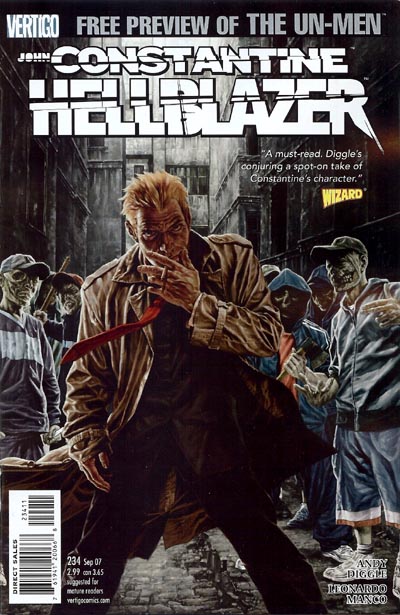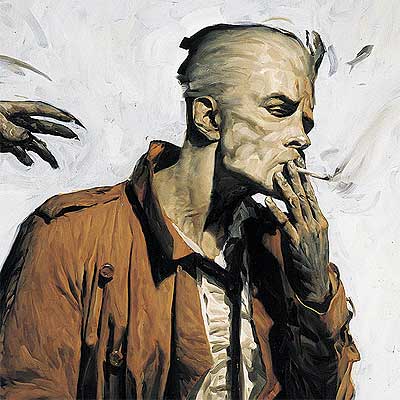
Television’s manufacturing of nostalgia often reduces the past to its most obvious series of events. Whether in revisiting popular culture on VH1’sI Love the ‘70s or in TV movies ranging from The ‘60s to The Kennedys, “the past” rarely adds up to anything more than what we already know about it. The past, then, becomes reduced to a series of iconic historical events that are imbued with the hindsight-benefit of the present rather than portrayed in a way that provides any sense of convincing every-dayness.
AMC’s Mad Men has largely avoided this trap. Where NBC’s The ‘60s framed the entire decide as a monolithic event whose every singular moment one nuclear family was improbably involved in, Mad Men integrates personal storylines into major events in a way that gives them a believable microscopic intimacy which make them feel like artifacts of the present: the Kennedy/Nixon election occurs in the background during a raucous and promiscuous office party in Season 1, Don Draper’s (John Hamm) marriage dissolves as the Cuban missile crisis escalates in Season 2, and Roger Sterling’s (John Slattery) daughter’s wedding is forebodingly scheduled on November 22, 1963 in Season 3.
But these are the events we have come to expect and anticipate Mad Men to touch upon as its timeline moves forward. What the show is particularly adept at doing – and what separates its from traditional and redundant encapsulations of our culture’s most-revisited decade – is its use of smaller moments. Examine the news landscape each week and you’ll notice how quickly our discourse moves from story to story without a sense of preservation. Only the most mammoth of moments make it into the memorial zeitgeist, but our everyday lives and daily conversations are determined much more often by the smaller stories which won’t make it into American History 101 textbooks or VH1’s I Love the ‘10s.
Throughout Season 5, Mad Men has revisited moments which have gone into historical obscurity, or resurrected cultural artifacts long forgotten, and the show has used these components to great effect in terms of developing its characters and storylines.
From the death of Pete Fox (“Tea Leaves,” 5.02) to the Richard Speck murders (“Mystery Date,” 5.03) to a brief mention of the Charles Whitman shooting (“Signal 30,” 5.04), this season has used the comparably uneventful year of 1966 (as opposed to, say, ’60, ’62, ’63, ’68 and ’69) as a springboard for examining how these events can either dramatically shape or imperceptibly move in and out of people’s lives.
Yes, mentions of these events are often employed as time stamps (sometimes gracefully, sometimes not) which avoids the periodizing effect of the title card declaring the date of each episodes’ setting. However, what’s interesting about the show’s integration of these events is not only their precision (the show’s writers have explained that period newspapers are what they first consult when structuring an episode), but that the proportion such events take on characters’ lives varies.
For instance, the Speck murders have a harrowing effect on the psyche of young Sally Draper (Kiernan Shipka), for whom reportage of the event is likely one of her first blunt exposures to both mortality and sexuality. “Mystery Date” ends with Sally hiding asleep under a love seat while clutching a kitchen knife. For many viewers like myself, this was the first we had heard of the Speck murders.
Meanwhile, in “Signal 30″ a young high school student all but casually mentions to Pete Campbell (Vincent Kartheiser) about the Whitman shootings on the University of Texas campus, an event that Pete seems to pay little mind. For Texans like my parents – and, I assume, much of the country – the Whitman shooting was a harrowing moment of seemingly unprecedented violence and inexplicable madness; the Columbine of thirty years’ prior so to speak. It’s an event that I knew full well about going into the show, yet it is not given near the breadth of time that the Speck murders are.

We each experience different events at different proportions depending upon when in our lives they occur. For young Sally, the Speck murders will likely remain for her a formative moment; while for the adult Pete who is too preoccupied with his own desires and blinded by his enduring crisis in masculinity to contemplate the implications of a tragedy like the UT shooting, an event that has since resonated through history shows up only as a blip on his radar. Why some events retain a space within cultural memory and others don’t is revealed by Mad Men to be rather arbitrary.
But perhaps more interesting than Mad Men’s anticipated representation of contemporaneous events is its portrayal of non-1966 culture and itsdeliberate omissions.
Mad Men’s highly anticipated two-hour season opener “A Little Kiss” (the highest-rated episode of the show to date) features Megan Draper(Jessica Paré) singing “Zou Bisou Bisou” as a seductive tribute to her husband Don on his birthday. This moment automatically became stratospherically famous, and the new-woman sexuality performed by Paré was transformed into the defining icon by which the rest of the season was assessed. Its success also inspired the release of a commercial single of Paré’s version of the song.
“Zou Bisou Bisou” is by no means a definitive song of 1966. The song’s origins have been debated since its use in Mad Men, but it’s often credited as a 1960 single by Gillian Hills, though several versions of the song exist (including one by Sophia Loren). “Zou Bisou Bisou” exemplifies the complex relationship between time and culture that isn’t often acknowledged in period television: we don’t always experience culture contemporaneously. Today, we don’t only consume culture from the year 2012; we continually reappropriate, revive, and recirculate past cultural artifacts. Thus, it’s no contradiction that “Zou Bisou Bisou” could acquire even more currency in 1966 (or 2012) than it did in the year of its initial release. Years past cannot be conceived only by the products of a given year, but as a selective accumulation of the culture from years before.
But what Mad Men doesn’t show us is just as important as what it does. While Don Draper, as evidenced by the last scene in this past Sunday’s episode (“Christmas Waltz,” 05.10) can certainly use his honed rhetoric to inspire a captive audience when need be, this season has made no secret of the fact that the complicated protagonist is losing his command of his own career. Where Don was able to hold his own with effortless coolness and confidence against, say, beatniks in Season 1, he’s slowly turning into a square as the counterculture becomes popular culture. This is perhaps best evidenced by his willful ignorance and dismissal of all things Beatles, illustrated most clearly in “Lady Lazarus” (05.08). Don spends much of the episode seeking a Beatlesque band to play a song for their ad campaign, and seeks out friendly teeny boppers akin to Please Please Me-era Fab Four. At the episode’s end, Megan plays for Don the LSD-inspired avant-dubbed track “Tomorrow Never Knows” from Revolver, which he stops before completion. The message is clear: Don can’t tell any substantive difference between “Tomorrow Never Knows” and, say, “I Want to Hold Your Hand.”
And this episode takes place in October 1967. Revolver was released after great anticipation two months prior. A moment occurred. Don missed it. So another message is equally clear: we aren’t always cognizant of the changes taking place in the present even as we live it.
But is Mad Men ultimately paying a price in focusing on the smaller events instead of the bigger ones? Yes, the approach that I’ve outlined above is a refreshingly nuanced take on period pieces that perhaps only the long-form audiovisual storytelling possibilities like television can afford (but rarely attempts). But are these small cultural intrusions adding up at the expense of larger ones? The opening and closing moments of “A Little Kiss” indicated that this would be the first season in which Mad Men acknowledged and dealt with the Civil Rights movement at length, but besides the introduction of Dawn (Yayonah Parris, who I’m pretty sure hasn’t spoken since “Mystery Date”), the show has shelved that storyline aside for now as the timeline rapidly approaches 1967. It will be interesting to see if Mad Men deals with 1968 (a year that, from hindsight, seems to only consist of major events) similarly to Season 5, or whether the writers will acknowledge that some events are too great not to permeate the walls of Sterling-Cooper-Draper-Price.
Mad Men, of course, isn’t history, but it is an important intervention in terms of how the 60s are represented and thus understood. Representing history inevitably involves selection. It’s not only important to acknowledge what gets highlighted and what gets left out, but also what gets re-circulated, what gets omitted entirely, and why.











No comments:
Post a Comment